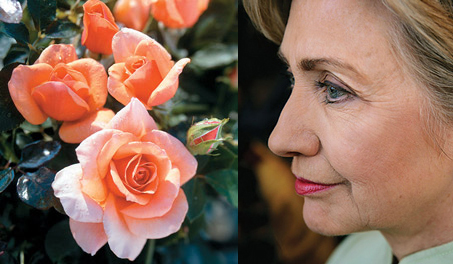If Hillary Clinton Wins Nevada, Florida, North Carolina and Other Close States, She Can Thank Gary Johnson
25% of the Libertarian's current supporters are Republicans compared to 10% Democrats


Today's big election news is that Hillary Clinton has built (in the words of CNN) "what could be an insurmountable edge in Nevada at the end of early voting," including a 72,000-vote advantage in Clark County alone. Nevada, which selected Barack Obama in 2008 and 2012, is nevertheless close to a must-win for Donald Trump, and the polling there has been so close that even as of this afternoon FiveThirtyEight estimated the Republican's chances of winning there at 50.4 percent.
There are many people Clinton can thank for eking out a win in Vegas—get-out-the-vote operatives, highly motivated Latinos, Steve Aoki, etc. But the future Mrs. President may want to save a bouquet of desert roses for Libertarian Party nominee Gary Johnson.
For much of the past half-year, Johnson's support was about equally comprised of Democrats, Republicans, and independents. Given his consistently impressive showing among Millennials, a key part of the Obama coalition, it's no wonder that Democrats were freaking out about and throwing millions at their perceived Johnson problem. "Vote for Johnson, elect Trump" warned lefty sourpuss Harold Meyerson. Well, that turned out to be almost exactly wrong.
If you look at a dozen national polls with detailed Johnson numbers over the past three weeks, a striking new pattern, which I first flagged here, has emerged: No longer is the Johnson coalition anything like a 33-33-33 split among Dems, Reps, and indies. Now, amidst the Libertarian losing around half his support over the past two months, his remaining base is consistently 10 percent Democrat, 25 percent Republican, and 65 percent independent. This ratio has been stable not just throughout national polls, but in the half-dozen or so detailed battleground state polls I've checked out.
What does that mean in, say, Nevada? Well, Johnson is at 5.3 percent there, according to FiveThirtyEight's poll average, while Trump and Clinton are tied at 46.7. If you add 10 percent of Johnson's totals to Clinton, and 25 percent to Trump, the Republican would have a lead of 48.0 percent to 47.2. The potential Johnson Effect here is worth about 0.8 percentage points in Clinton's direction.
Yes, yes, there is no such thing as a spoiler, votes do not inherently belong to anybody, and so on. It is plausible, I suppose, that 100 percent of Johnson's voters in Nevada would have just stayed home if his name was not on the ballot. But it's also possible that consumers change behavior when presented with more options (especially palatable ones), altering the shape of the overall market.
As mentioned before, the 10/25/65 D/R/I ratio of Johnson's support is stable across battleground states where polling is sophisticated enough to check. So where else could there be a Johnson Effect, if you choose to believe in such things? Basically, wherever it's close, or possibly in some Johnson-friendly states that don't look close now but might end up that way.
After the jump, and with the caveat that Johnson's eventual numbers will likely be lower than those shown below (given his current trajectory, and the history of third-party underperformance on Election Day), take a look at some possibilities of the Libertarian nominee's impact on states. Polling numbers were culled last night, averaged out between FiveThirtyEight and RealClearPolitics with the exception of the not-very-well-polled Alaska in which I just used the former. Numbers do change fast, so please do your own follow-up calculations at home!
Florida
Current spread: Zero (DT 47.9, HC 47.9)
538 odds: DT 54.5, HC 45.5
GJ polling: 2.4% (it's one of his worse states)
Johnson Effect: 0.4 percentage points
New Hampshire
Current spread: 0.1 percentage points (HC 44.3, DT 44.2)
538 odds: HC 60.8, DT 39.2
GJ polling: 6.6%
Johnson Effect: 1.1 percentage points
North Carolina
Current spread: 0.6 percentage points (DT 47.6, HC 47.0)
538 odds: DT 54.7, HC 45.3
GJ polling: 3.3%
Johnson Effect: 0.5 percentage points
Iowa
Current spread: 2.8 percentage points
538 odds: DT 71.7, HC 28.3
GJ polling: 5.0%
Johnson Effect: 0.8 percentage points
Ohio
Current spread: 3.0 percentage points (DT 47.5, HC 44.5)
538 odds: DT 70.3, HC 29.7
GJ polling: 4.5%
Johnson Effect: 0.6 percentage points
Arizona
Current spread: 3.8 percentage points (DT 47.4, HC 43.6)
538 odds: DT 75.8, HC 24.1, GJ 0.1!
GJ polling: 5.2%
Johnson Effect: 0.8 percentage points
New Mexico
Current spread: 6.9 percentage points (HC 44.1, DT 37.9)
538 odds: HC 82.1, DT 17.4, GJ 0.4
GJ polling: 14.0%
Johnson Effect: 2.8 percentage points
Colorado
Current spread: 3.2 percentage points (HC 45.8, DT 42.6)
538 odds: HC 73.7, DT 26.3
GJ polling: 6.4%
Johnson Effect: 1.0 percentage points
Alaska
Current spread: 7.8 percentage points (DT 48.4, HC 40.6)
538 odds: DT 78.8, HC 21.1, GJ 0.1
GJ polling: 9.4%
Johnson Effect: 1.3 percentage points
Michigan
Current spread: 4.3 percentage points (HC 47.3, DT 43.0)
538 odds: HC 76.7, DT 23.3
GJ polling: 5.2%
Johnson Effect: 0.8 percentage points
Wisconsin
Current spread: 4.8 percentage points (HC 47.6, DT 42.8)
538 odds: HC 78.5, DT 21.5
GJ polling: 5.2%
Johnson Effect: 0.8 percentage point
Georgia
Current spread: 4.9 percentage points (DT 49.3, HC 44.4)
538 odds: DT 85.7, HC 14.3
GJ polling: 4.7%
Johnson Effect: 0.6 percentage points


Show Comments (358)